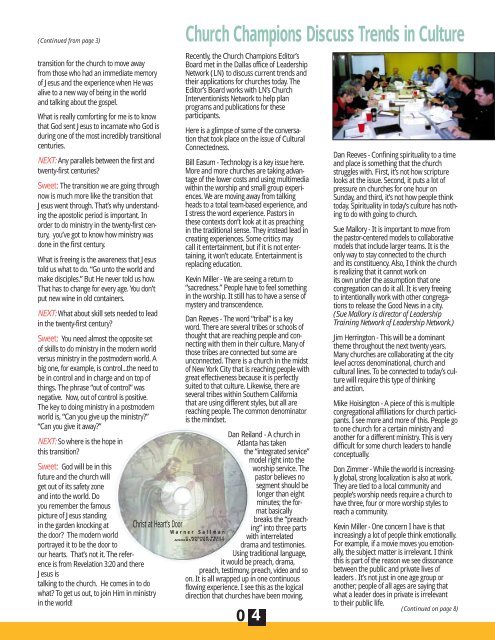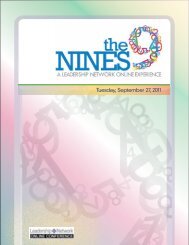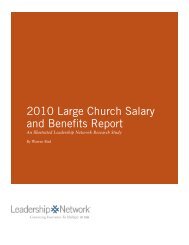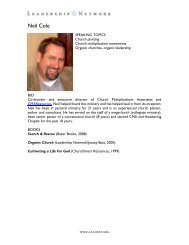ARE WE A PEOPLE AT HALF TIME? - Leadership Network
ARE WE A PEOPLE AT HALF TIME? - Leadership Network
ARE WE A PEOPLE AT HALF TIME? - Leadership Network
You also want an ePaper? Increase the reach of your titles
YUMPU automatically turns print PDFs into web optimized ePapers that Google loves.
(Continued from page 3)<br />
transition for the church to move away<br />
from those who had an immediate memory<br />
of Jesus and the experience when He was<br />
alive to a new way of being in the world<br />
and talking about the gospel.<br />
What is really comforting for me is to know<br />
that God sent Jesus to incarnate who God is<br />
during one of the most incredibly transitional<br />
centuries.<br />
NEXT: Any parallels between the first and<br />
twenty-first centuries<br />
Sweet: The transition we are going through<br />
now is much more like the transition that<br />
Jesus went through. That’s why understanding<br />
the apostolic period is important. In<br />
order to do ministry in the twenty-first century,<br />
you’ve got to know how ministry was<br />
done in the first century.<br />
What is freeing is the awareness that Jesus<br />
told us what to do. “Go unto the world and<br />
make disciples.” But He never told us how.<br />
That has to change for every age. You don’t<br />
put new wine in old containers.<br />
NEXT: What about skill sets needed to lead<br />
in the twenty-first century<br />
Sweet: You need almost the opposite set<br />
of skills to do ministry in the modern world<br />
versus ministry in the postmodern world. A<br />
big one, for example, is control...the need to<br />
be in control and in charge and on top of<br />
things. The phrase “out of control” was<br />
negative. Now, out of control is positive.<br />
The key to doing ministry in a postmodern<br />
world is, “Can you give up the ministry”<br />
“Can you give it away”<br />
NEXT: So where is the hope in<br />
this transition<br />
Sweet: God will be in this<br />
future and the church will<br />
get out of its safety zone<br />
and into the world. Do<br />
you remember the famous<br />
picture of Jesus standing<br />
in the garden knocking at<br />
the door The modern world<br />
portrayed it to be the door to<br />
our hearts. That’s not it. The reference<br />
is from Revelation 3:20 and there<br />
Jesus is<br />
talking to the church. He comes in to do<br />
what To get us out, to join Him in ministry<br />
in the world!<br />
Christ at Heart’s Door<br />
W arner Sallman<br />
Church Champions Discuss Trends in Culture<br />
Recently, the Church Champions Editor’s<br />
Board met in the Dallas office of <strong>Leadership</strong><br />
<strong>Network</strong> (LN) to discuss current trends and<br />
their applications for churches today. The<br />
Editor’s Board works with LN’s Church<br />
Interventionists <strong>Network</strong> to help plan<br />
programs and publications for these<br />
participants.<br />
Here is a glimpse of some of the conversation<br />
that took place on the issue of Cultural<br />
Connectedness.<br />
Bill Easum - Technology is a key issue here.<br />
More and more churches are taking advantage<br />
of the lower costs and using multimedia<br />
within the worship and small group experiences.<br />
We are moving away from talking<br />
heads to a total team-based experience, and<br />
I stress the word experience. Pastors in<br />
these contexts don’t look at it as preaching<br />
in the traditional sense. They instead lead in<br />
creating experiences. Some critics may<br />
call it entertainment, but if it is not entertaining,<br />
it won’t educate. Entertainment is<br />
replacing education.<br />
Kevin Miller - We are seeing a return to<br />
“sacredness.” People have to feel something<br />
in the worship. It still has to have a sense of<br />
mystery and transcendence.<br />
Dan Reeves - The word “tribal” is a key<br />
word. There are several tribes or schools of<br />
thought that are reaching people and connecting<br />
with them in their culture. Many of<br />
those tribes are connected but some are<br />
unconnected. There is a church in the midst<br />
of New York City that is reaching people with<br />
great effectiveness because it is perfectly<br />
suited to that culture. Likewise, there are<br />
several tribes within Southern California<br />
that are using different styles, but all are<br />
reaching people. The common denominator<br />
is the mindset.<br />
Dan Reiland - A church in<br />
Atlanta has taken<br />
the “integrated service”<br />
model right into the<br />
worship service. The<br />
pastor believes no<br />
segment should be<br />
longer than eight<br />
minutes; the format<br />
basically<br />
breaks the “preaching”<br />
into three parts<br />
with interrelated<br />
drama and testimonies.<br />
Using traditional language,<br />
it would be preach, drama,<br />
preach, testimony, preach, video and so<br />
© WARNER PRESS<br />
ANDERSON UNIVERSITY<br />
on. It is all wrapped up in one continuous<br />
flowing experience. I see this as the logical<br />
direction that churches have been moving.<br />
0 4<br />
Dan Reeves - Confining spirituality to a time<br />
and place is something that the church<br />
struggles with. First, it’s not how scripture<br />
looks at the issue. Second, it puts a lot of<br />
pressure on churches for one hour on<br />
Sunday, and third, it’s not how people think<br />
today. Spirituality in today’s culture has nothing<br />
to do with going to church.<br />
Sue Mallory - It is important to move from<br />
the pastor-centered models to collaborative<br />
models that include larger teams. It is the<br />
only way to stay connected to the church<br />
and its constituency. Also, I think the church<br />
is realizing that it cannot work on<br />
its own under the assumption that one<br />
congregation can do it all. It is very freeing<br />
to intentionally work with other congregations<br />
to release the Good News in a city.<br />
(Sue Mallory is director of <strong>Leadership</strong><br />
Training <strong>Network</strong> of <strong>Leadership</strong> <strong>Network</strong>.)<br />
Jim Herrington - This will be a dominant<br />
theme throughout the next twenty years.<br />
Many churches are collaborating at the city<br />
level across denominational, church and<br />
cultural lines. To be connected to today’s culture<br />
will require this type of thinking<br />
and action.<br />
Mike Hoisington - A piece of this is multiple<br />
congregational affiliations for church participants.<br />
I see more and more of this. People go<br />
to one church for a certain ministry and<br />
another for a different ministry. This is very<br />
difficult for some church leaders to handle<br />
conceptually.<br />
Don Zimmer - While the world is increasingly<br />
global, strong localization is also at work.<br />
They are tied to a local community and<br />
people’s worship needs require a church to<br />
have three, four or more worship styles to<br />
reach a community.<br />
Kevin Miller - One concern I have is that<br />
increasingly a lot of people think emotionally.<br />
For example, if a movie moves you emotionally,<br />
the subject matter is irrelevant. I think<br />
this is part of the reason we see dissonance<br />
between the public and private lives of<br />
leaders . It’s not just in one age group or<br />
another; people of all ages are saying that<br />
what a leader does in private is irrelevant<br />
to their public life.<br />
(Continued on page 8)







